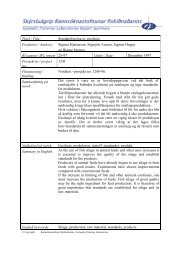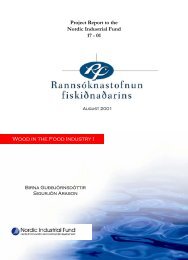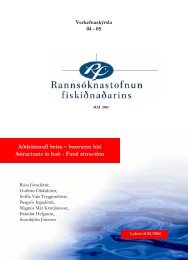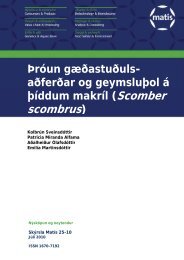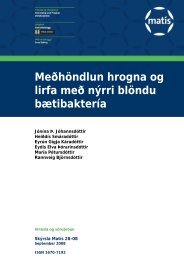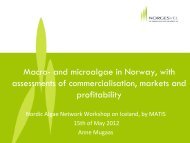Microbiology and Spoilage Trail in Nile Perch (Lates niloticus), Lake ...
Microbiology and Spoilage Trail in Nile Perch (Lates niloticus), Lake ...
Microbiology and Spoilage Trail in Nile Perch (Lates niloticus), Lake ...
You also want an ePaper? Increase the reach of your titles
YUMPU automatically turns print PDFs into web optimized ePapers that Google loves.
is <strong>in</strong>sufficient for good quality <strong>and</strong> extension of their shelf life. At present super chill<strong>in</strong>g of<br />
fresh chilled fish products is applied by some fish establishments. Fish fillets/products are<br />
rapidly chilled to below 0 to -2 o C by us<strong>in</strong>g either blast, plate or tunnel freezers. Various<br />
types of cool<strong>in</strong>g systems have been used for super chill<strong>in</strong>g (at -4 to 0 o C) of seafood<br />
products. Examples of the cool<strong>in</strong>g systems <strong>in</strong>clude chilled <strong>and</strong> refrigerated seawater (Smith<br />
et al. 1980, Olafsdottir et al. 2000), liquid-ice <strong>and</strong> br<strong>in</strong>e solutions (Huidobro et al. 2002),<br />
flake ice or slurry ice (Losada et al. 2005, Zeng et al. 2005), subzero storage temperature; -<br />
2 <strong>and</strong> -3 o C, (Riaz-Fatima et al. 1988, Sivertsvik et al. 2003) <strong>and</strong> the use of cool<strong>in</strong>g agents<br />
like CO2, <strong>and</strong> snow (LeBlanc <strong>and</strong> LeBlanc 1992, Jeyasekaran et al. 2004).<br />
2.6 METHODS FOR ASSESSMENT OF FRESH FISH QUALITY<br />
The qualitative <strong>and</strong> quantitative detection methods for SSO are <strong>in</strong> place. They <strong>in</strong>clude<br />
physical, sensory, microbial <strong>and</strong> biochemical (chemical) determ<strong>in</strong>ation methods.<br />
2.6.1 Sensory (qualitative) methods<br />
Sensory evaluation is def<strong>in</strong>ed as the scientific discipl<strong>in</strong>e used to evoke, measure, analyze<br />
<strong>and</strong> <strong>in</strong>terpret reactions to quality attributes of food as perceived through the human senses.<br />
The most used sensory assessment of fish freshness employs tra<strong>in</strong>ed persons called<br />
panellist to assess the fish by us<strong>in</strong>g the five common senses of humans, by see<strong>in</strong>g (eye),<br />
touch<strong>in</strong>g (sk<strong>in</strong>), smell<strong>in</strong>g (nose), hear<strong>in</strong>g (ear) <strong>and</strong> taste (tongue) aga<strong>in</strong>st a pre-set rank<strong>in</strong>g<br />
criteria. EU scheme <strong>and</strong> Quality Index Method (QIM) have been the most promis<strong>in</strong>g<br />
methods <strong>in</strong> measur<strong>in</strong>g the freshness of whole fish, which are rapid <strong>and</strong> reliable. Instruments<br />
as well may be used to measure some sensory profiles (parameters) i.e. Instron, Bohl<strong>in</strong><br />
Rheometer for measur<strong>in</strong>g texture <strong>and</strong> other rheological properties; microscopic methods<br />
comb<strong>in</strong>ed with image analyser are used to assess structural changes <strong>and</strong> "the artificial nose"<br />
to evaluate odour profile (Nanto et al., 1993). The sensory evaluation is generally the<br />
satisfactory <strong>and</strong> important method for assessment of fish freshness <strong>and</strong> or spoilage,<br />
(Connell, 1975; Re<strong>in</strong>eccius, 1990). It has been commonly used <strong>in</strong> the fish sector <strong>and</strong> fish<br />
<strong>in</strong>spection services (Luten <strong>and</strong> Mart<strong>in</strong>sdóttir 1997).<br />
22




